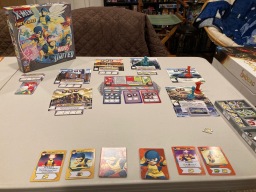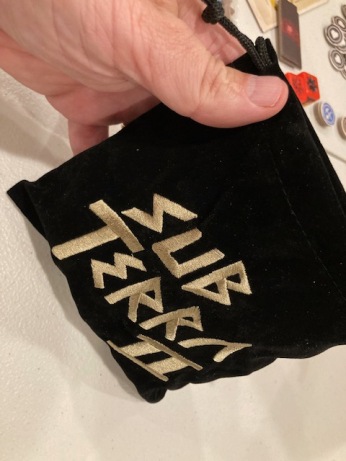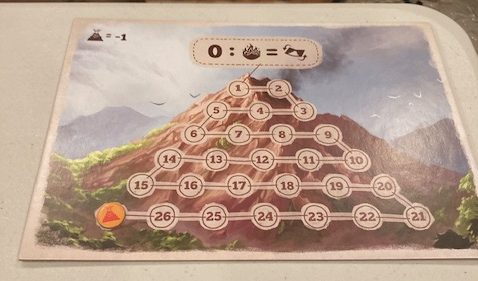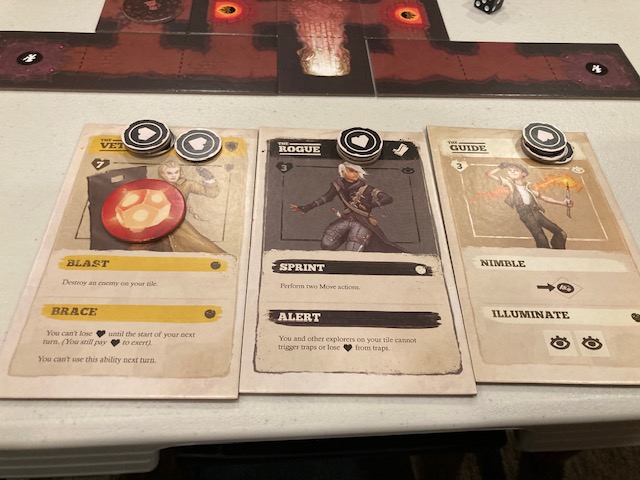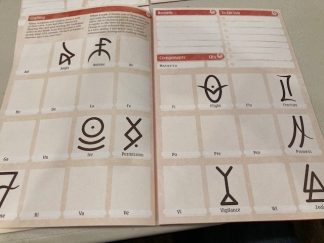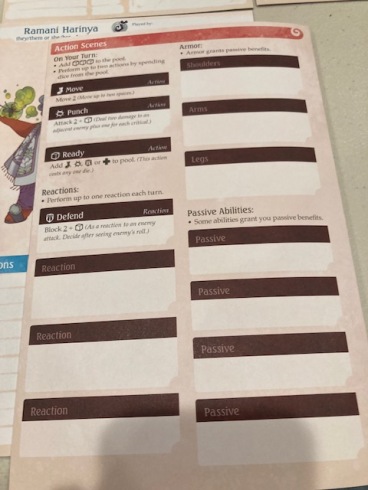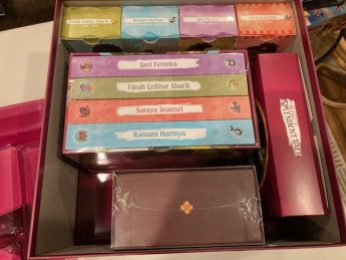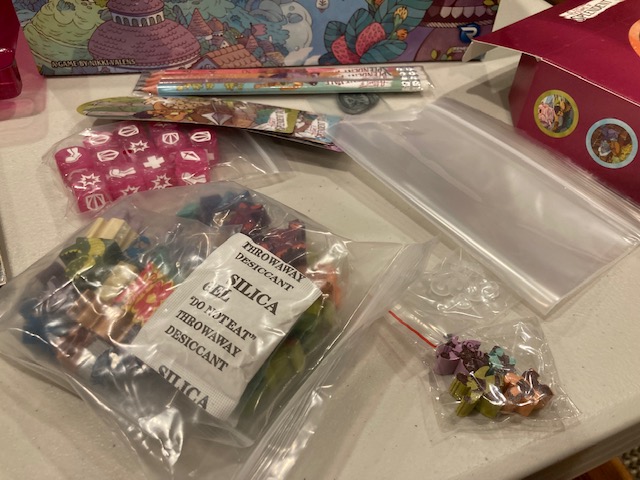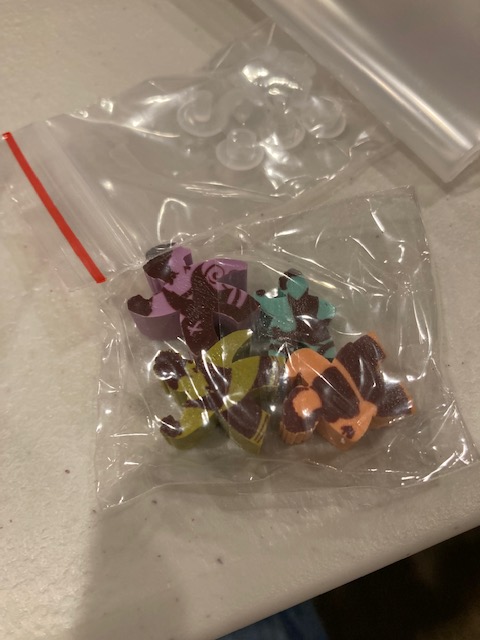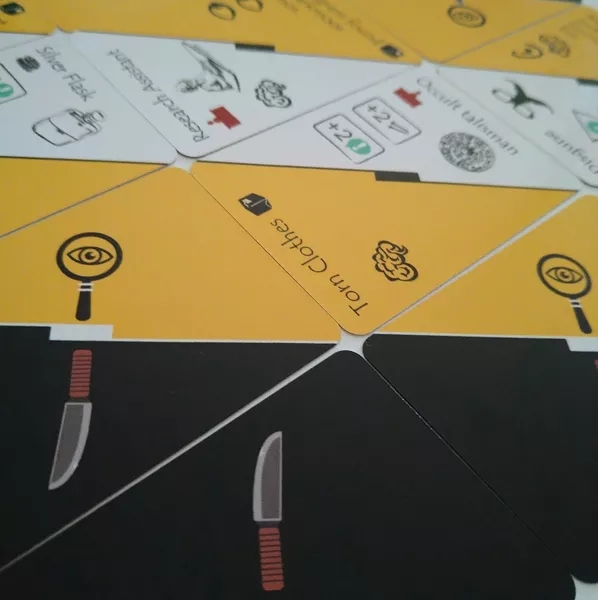
Sentinels of the Multiverse (Definitive Edition): Rook City Renegades was on Kickstarter back in March 2022. It delivered to me in the USA about 4 days ago, January 19th 2023. It promised delivery in January 2023. It was on time!! Holy cow, that’s an event unto itself: if you follow our blog, we’re usually “happy” if a Kickstarter is only a few months late. Kudos to Greater Than Games for getting their games out on schedule!

This expansion only expands the Definitive Version of the Sentinels of The Multiverse: see our review here to make sure you understand the differences between the 1st, 2nd, and Definitive Editions before you get this. Essentially, if you have the yellow box (below left), you have the proper edition.

Let’s take a look below!
Components
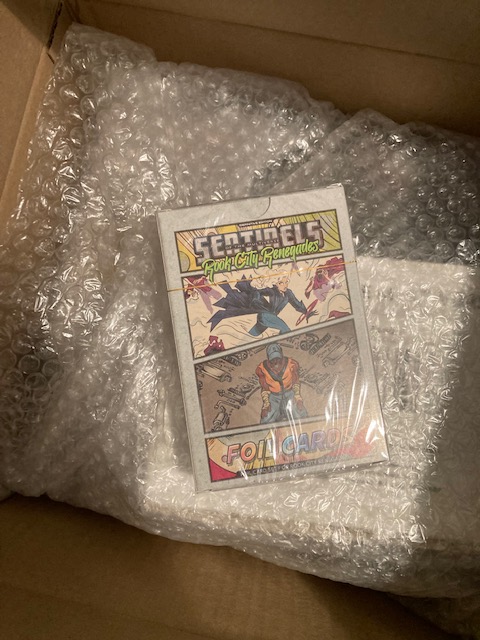
This is the Kickstarter version we will be looking at: it includes the expansion itself, foil card replacements for many of the bigger cards, and sleeves: see below.

This is an expansion in the simplest sense: it just adds new cards with minimal new rules. The only “real” new rule is the Suddenly! keyword (see below): it forces cards to be played immediately when they are drawn.

The box itself is the same size as the Definitive Edition (so that’s good for consistency and storage): see the box below with a can of Coke for perspective.


There are a few tokens that will be specific to a hero/villain/environment, a few more one damage tokens (we were always running out of those, so that’s good), and a new damage tracker. Why a new damage tracker? Because The Chairman has a second supporting Villain (The Operative) that has enough hit points to merit a new damage tracker. EDIT: Correction: the new tokens are really just the Irreducible tokens (the purples). The red Vs are nemesis tokens (just more copies, they are also found in the base box), and some more one damage tokens.

They also included another wheel. Not sure why? It doesn’t seem to go to anything. It seems to just be a backup piece of cardboard. EDIT: It was to replace the large wheel from the core game (which didn’t spin as well). This was said in the rulebook and I missed it the first time.

The rest of the game is just cards: see above and below.

I spent the first night just sleeving those cards. Sigh. No fun.

Everything in Rook City Renegades is nice quality and consistent with the Sentinels of the Multiverse Definitive Edition.
Foil Cards

The first thing I opened and sleeved were the foil cards! These are just “embossed foil” versions of all the larger cards in the expansion. (So, you will have two copies of each of these cards: the original and the foil version). I’ve said this many times: I love the foil Cards! Why don’t more games have foil cards? I think they are so thematic: Comics in the late 80s ad 90s used the use foil covers as a marketing gimmick to get noticed! And it worked in many cases! (You don’t see foil covers as much anymore in comics).
I have heard some people say they are too shiny to read, but I haven’t had that problem.

The first set of foil cards are all the Heroes of Rook City Renegades! There’s at least 3 different versions of each Hero!

There’s also a few alternate version for some of the base game Heroes included: I think the Haunted Fanatic (above) may be my favorite.

Sentinels also really embraces the “first appearance” and “last appearance” ideas: there are alternate versions of the Heroes and their powers, depending on their “first appearance”! These are kind of cool because it really feels like you are embracing the Sentinels of the Multiverse universe: it feels like it adds some depth and backstory (even though there was never really a Sentinels Comics).

Each Villain also has an equivalent foil card (see the right hand side above).

I didn’t even sleeve the “original” non-foil versions of any of the cards. I will always pay with the foil versions! I love them so much!
New Heroes and Villains and Environments

Like I said, this is an expansion that just really gives you more cards!

There are six new Heroes. Interestingly, most of the other Heroes (Setback, Expatriate, Mr. Fixer, Nightmist, and Harpy) appeared in the 2nd Edition or in an expansion, but Alpha is brand new!

There are five new Environments: Rook City, Pike Industrial Complex, The Realm of Discord, and The Temple o Zhu Long, and Diamond Manor. All but one appeared somewhere in the 2nd Edition, but Diamond Manor is new!

There are ten new Villains: Ambuscade, Apex, The Chairman, TheOperative, The Fey Court, Gloomweaver, Kismet, Plague Rat, Spite, and Terrorform. Of those, The Chairman and The Operative operate as one unit, so they are one villain. All of those Villains have appeared somewhere in 2nd edition except for Apex, The Fey Court, and Terrorform.

Luckily, everything fits pretty well in the box: see above.

One problem I had with the base box was the at names of the heroes/villains/environments were hidden by the sleeves!

Luckily, they have fixed that and you can read the dividers (even when the cards are sleeved) in the Rook City Renegades expansion.
Rulebook

As an expansion, the rulebook is less important. Or is it?


I still like seeing the components with correlating pictures: we have that here. See above.

The rulebook passes The Chair Test with an A-: it fits well on the chair next to me, but I had to break its spine and fold it back a few times to get the pages to stay open.
What this rulebook does well is that it has a FAQ, and explanations for each Hero/Villain/Environment in great detail: this inlcudes both thematic explanations as well as rules clarifications. I think this was pretty great: I had to go looking for a few clarifications, and they were either there in the FAQ or by the Hero/Villain/Environment section of interest.

Interestingly, Greater Than Games chose to use the back cover as an ad for the next expansion. I wish they had used the back cover to replicate the Turn Sequence and Useful Terms that are on the back of the main rulebook: see below.

Since this was an expansion, I didn’t expect too much from the rulebook: but Rook City Renegades delivered! This is what I want in an expansion rulebook! FAQs and lots of discussions of new content!
EDIT: It turns out, in the large cards that I did NOT open (because I love the foil cards so much) were some player summary cards! See below. The back of the rulebook isn’t quite as necessary.

Gameplay

In all version of Sentinels of the Multiverse, most of the rules for the game are on the cards, with the Turn Sequence simply providing the main flow. The first few times through play, it will be slow as we will have to read everything closely to get a sense of the decks. But this is just how Sentinels flows. You need to play a Hero a number of times to get familiar with the deck, and then it begins to flow much quicker.
The basic gameplay with the expansion is still the game as the original game: the game does’t really really change with this expansion. If you were looking for Rook City Renegades to change up Sentinels of the Multiverse: Definitive Edition significantly, then you will be disappointed. The Suddenly cards are the only real “new” rule … they add some chaos, as those cards that have to be played as soon as they are drawn.

Solo Play
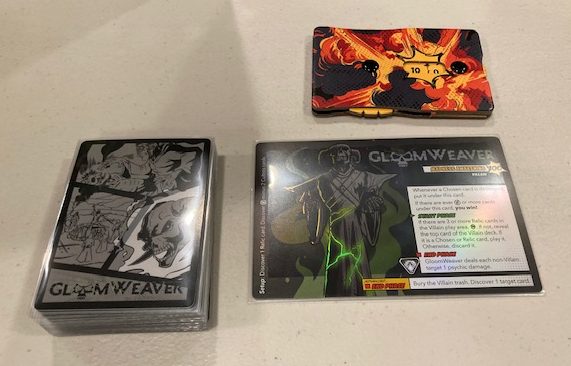
My first Villain, randomly chosen, was Gloomweaver (Gloomweaver originally comes from the Infernal Relics Expansion in 2nd Edition). As I looked through the Heroes, it made sense to have some mystic Heroes fight!

Nightmist seemed the obvious first choice, as she is the spellcaster and mystical foil to Gloomweaver (and she also comes from the same Infernal Relics Expansion from the 2nd Edition) Which version of Nightmist should I take? There are a bunch of versions to choose from: Base, Dark Watch, Magical Mentor (see above). I liked that I had a choice: in the end, I went with the Dark Watch version … somehow that seemed apropos.
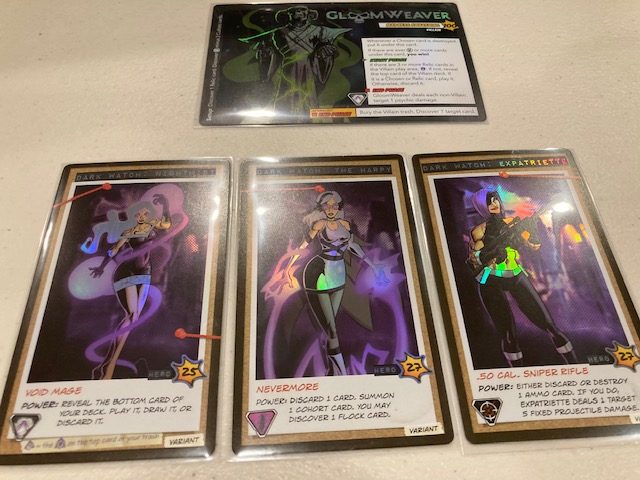
And Harpy seemed a good joiner, as her abilities are sorta weird and mystical. And Expatriette, with her hardcore gun knowledge seemed a good backup for the vaguely mystical other two.
What’s a weird place for Gloomweaver to appear? The Diamond Manner!

To me, this was all about building a story: Nightmist finds out about Gloomweaver’s incursion into our world. She recruits her friend Harpy to help her, and Harpy suggests some real world firepower in the form of Expatriette! “Just In Case“. The three form the Dark Watch and track Gloomweaver to the Diamond Mansion … and an epic battle begins!

Nightmist leads the group!

The Harpy will follow Nightmist to hell and back!

And Expatriette covers their back!

And so we set-up for our first solo game of the “Into the Dark” with the Dark Watch!
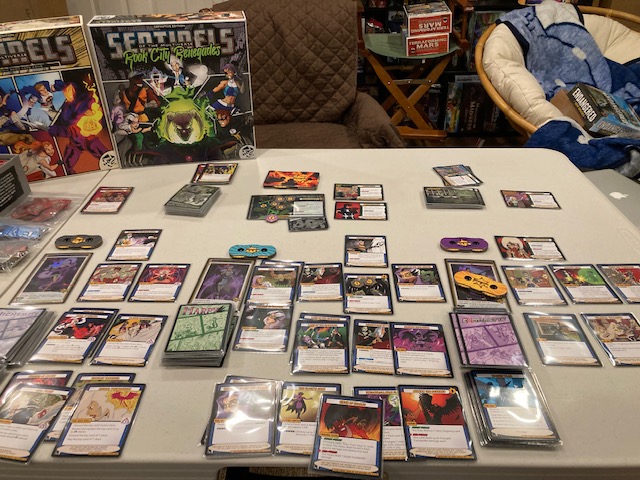
So, this game was very intense: there were a lot of rules to follow! Even though I have played all three Heroes in the 2nd Edition, you might think it would easier to play, but they weren’t! The Heroes are similar but not similar enough, so I had to read each Hero’s abilities very closely so I didn’t “accidentally” assume some rules from the 2nd Edition! …which I still ended up doing for Gloomweaver.

In fact, I had won the game earlier than I realized, as I had taken out three Chosen earlier in the game! I was remembering the rules in the 2nd Edition, where you have to take out 3 Relics (instead of 3 Chosen).

I did win my Dark Watch game, beating Gloomweaver back, but I made a few mistakes … even though I tried really hard to follow all the rules. Simply speaking, there are a lot of rules to keep track of. Those mistakes and missteps are simply part of the learning process for Sentinels of the Multiverse: it’s always been that way. It always takes a little bit to learn the decks.

These Heroes in Rook City Renegades in general seem more complicated than the Heroes from the base game: caveat emptor.
But, I had fun as a solo player: I wrote my own story in my mind, I formed my own team, I played out the battle, and I had a ball discovering how all the Heroes and Villains and Environments work! That’s part of the fun of Sentinels of the Multiverse: discovering how the decks work. If you don’t enjoy that, you will probably never enjoy this game.
Cooperative Play
Our only real constraint for cooperative play was that we must play with as much new content as possible! Everything came from the new set.

Like the solo game, we tried to tell a story as we set-up the cooperative game.

Terrorform (with his cool foil card) had appeared and taken over the Diamond Manor! (I know, it seems like a popular place for the Bad Guys to go).

Setback, the young kid, found out about Terrorform coming while monitoring the coms! He knew that Diamond Manor was all “magical and weird” (his words), so he went to find the mystic Nightmist!

Turns out Nightmist was having wine party for her two friends Alpha and Harpy, so they were all happy to help!


In the end, it was Setback, the young pun kid, helping out the 3 experienced heroes!

The little story we told kind of “got us into” the game a little, as we felt a little more closer to our characters and each other. Again, like the original game, there was some downtime as we read cards and tried to figure out how all the characters worked.

In the end, we defeated Terrorform: it took a little longer than we expected (2.5 hours?), but we also had all new content for all us, so there was definitely a learning curve. We all had fun. The characters seemed just a little more complex than the original game.
Trust Enhances Cooperation

I’ve had a good friend (none of the people here, but he’ll be reading this blog entry soon) tell me he doesn’t like Sentinels because “I don’t know what other people are doing!” I actually kind of like that: I don’t have to know what everyone’s doing because I trust them! This is a cooperative game! We are all doing the best we can, and if you take your turn and feel like you did it right, I am happy! We are working together, we are not micromanaging each other!

Sentinels definitely needs that trust factor to move forward: each character (especially in the new set) has a lot of rules to learn. I actually think that enhances the cooperation a little: it forces us to trust each other and have faith that we all played our turns the best we could: I trust my fellow heroes.

Standalone Expansion?

I was always annoyed that the Token box from the base game didn’t really fit into the box (yes, yes, I know there are ways to make it fit, but I didn’t like how tight it was: we discussed it on our review here). However, it ended up being an unexpected benefit: if you have the Token box, you don’t need the base game! All the counters and condition counters that you need are all in the Token box! So, if you really want to, you could play with JUST Rook City Renegades and the Token box! You would get all new content with the expansion! The only thing you need from the base game is the Token box!
I mean, that’s what we did for our first solo game: 3 new Heroes, 1 new Villain, and 1 new Environment with just the Token box from the original game.

In fact, I would argue you don’t even need the Token box! You could play Rook City Renegades without the Token box! Back in the 1st Edition, there were no tokens: you had to either supply your own tokens, or use pencil and paper. I played many a 1st Edition game with just pencil and paper … I didn’t need no stinkin’ tokens.

… but you still have to know the rules of the game. The base box has the rulebook, which might be the one thing you have to have from the base game.

If you were very enterprising, this could be a standalone expansion: You could lookup the rules online, and use your own tokens/pencil-and-paper to form Rook City Renegades into a standalone expansion.

But why would you? The tokens and damage trackers from the base game (in the Token box) really are a step forward in making the game easier to play: don’t step back to 2011 and opt for pencil and paper like I had to! Use all the modern tools to make your game more fun!
Conclusion

Rook City Renegades is a great expansion, adding 6 new Heroes, 10 new Villains, and 5 new Environments! It expands the game in whatever direction you want: do you want new Heroes to play? New Villains to fight? New places to fight? Sentinels of the Multiverse: Definitive Edition Rook City Renegades makes it easy to add new content, whatever you want that to be.

I don’t think you need this expansion right away, as the new expansion does add more complexity: each new Hero seems just a little more complicated: For Example: Nightmist, with her spell-casting, adds more rules and complexity to the game. This is a great expansion, I just don’t think you need it until you feel like you’ve exhausted the base game.

Back in 2nd Edition, Rook City was my favorite expansion for Sentinels of the Multiverse: I loved the new Environments and new Villains … fun fact, I didn’t love the new Heroes as much, but I loved that I could expand my favorite game. The Definitive Edition of Rook City Renegades does the 2nd edition justice: it adds fantastic new Villains, Heroes, and Environments.
Rook City Renegades is a great expansion: When you are ready for it, it will be fantastic.


















































